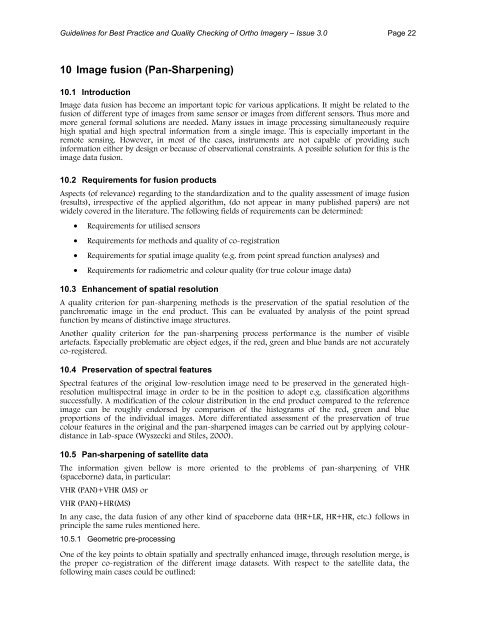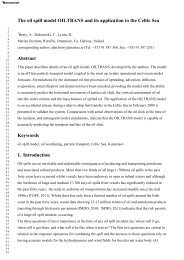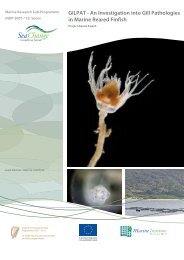Guidelines for Best Practice and Quality Checking of Ortho Imagery
Guidelines for Best Practice and Quality Checking of Ortho Imagery
Guidelines for Best Practice and Quality Checking of Ortho Imagery
Create successful ePaper yourself
Turn your PDF publications into a flip-book with our unique Google optimized e-Paper software.
<strong>Guidelines</strong> <strong>for</strong> <strong>Best</strong> <strong>Practice</strong> <strong>and</strong> <strong>Quality</strong> <strong>Checking</strong> <strong>of</strong> <strong>Ortho</strong> <strong>Imagery</strong> – Issue 3.0 Page 2210 Image fusion (Pan-Sharpening)10.1 IntroductionImage data fusion has become an important topic <strong>for</strong> various applications. It might be related to thefusion <strong>of</strong> different type <strong>of</strong> images from same sensor or images from different sensors. Thus more <strong>and</strong>more general <strong>for</strong>mal solutions are needed. Many issues in image processing simultaneously requirehigh spatial <strong>and</strong> high spectral in<strong>for</strong>mation from a single image. This is especially important in theremote sensing. However, in most <strong>of</strong> the cases, instruments are not capable <strong>of</strong> providing suchin<strong>for</strong>mation either by design or because <strong>of</strong> observational constraints. A possible solution <strong>for</strong> this is theimage data fusion.10.2 Requirements <strong>for</strong> fusion productsAspects (<strong>of</strong> relevance) regarding to the st<strong>and</strong>ardization <strong>and</strong> to the quality assessment <strong>of</strong> image fusion(results), irrespective <strong>of</strong> the applied algorithm, (do not appear in many published papers) are notwidely covered in the literature. The following fields <strong>of</strong> requirements can be determined:• Requirements <strong>for</strong> utilised sensors• Requirements <strong>for</strong> methods <strong>and</strong> quality <strong>of</strong> co-registration• Requirements <strong>for</strong> spatial image quality (e.g. from point spread function analyses) <strong>and</strong>• Requirements <strong>for</strong> radiometric <strong>and</strong> colour quality (<strong>for</strong> true colour image data)10.3 Enhancement <strong>of</strong> spatial resolutionA quality criterion <strong>for</strong> pan-sharpening methods is the preservation <strong>of</strong> the spatial resolution <strong>of</strong> thepanchromatic image in the end product. This can be evaluated by analysis <strong>of</strong> the point spreadfunction by means <strong>of</strong> distinctive image structures.Another quality criterion <strong>for</strong> the pan-sharpening process per<strong>for</strong>mance is the number <strong>of</strong> visibleartefacts. Especially problematic are object edges, if the red, green <strong>and</strong> blue b<strong>and</strong>s are not accuratelyco-registered.10.4 Preservation <strong>of</strong> spectral featuresSpectral features <strong>of</strong> the original low-resolution image need to be preserved in the generated highresolutionmultispectral image in order to be in the position to adopt e.g. classification algorithmssuccessfully. A modification <strong>of</strong> the colour distribution in the end product compared to the referenceimage can be roughly endorsed by comparison <strong>of</strong> the histograms <strong>of</strong> the red, green <strong>and</strong> blueproportions <strong>of</strong> the individual images. More differentiated assessment <strong>of</strong> the preservation <strong>of</strong> truecolour features in the original <strong>and</strong> the pan-sharpened images can be carried out by applying colourdistancein Lab-space (Wyszecki <strong>and</strong> Stiles, 2000).10.5 Pan-sharpening <strong>of</strong> satellite dataThe in<strong>for</strong>mation given bellow is more oriented to the problems <strong>of</strong> pan-sharpening <strong>of</strong> VHR(spaceborne) data, in particular:VHR (PAN)+VHR (MS) orVHR (PAN)+HR(MS)In any case, the data fusion <strong>of</strong> any other kind <strong>of</strong> spaceborne data (HR+LR, HR+HR, etc.) follows inprinciple the same rules mentioned here.10.5.1 Geometric pre-processingOne <strong>of</strong> the key points to obtain spatially <strong>and</strong> spectrally enhanced image, through resolution merge, isthe proper co-registration <strong>of</strong> the different image datasets. With respect to the satellite data, thefollowing main cases could be outlined:
















